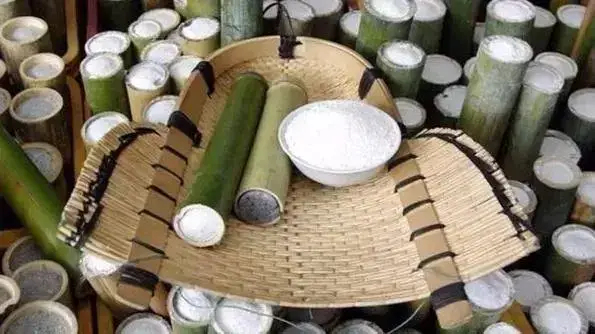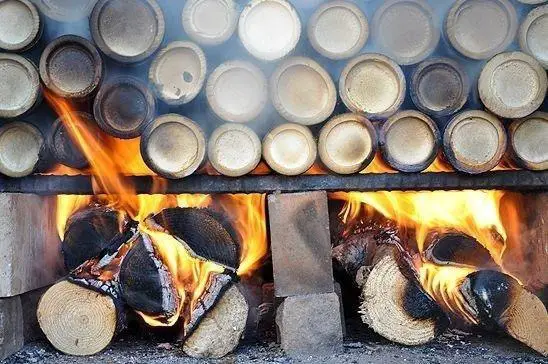Bamboo salt is a substance refined by filling three-year-old bamboo with sun-dried salt, sealing both ends with natural loess, and then calcining it at a high temperature of 1000°C to 1300°C using pine wood as fuel. According to folklore, during the late Eastern Jin Dynasty, smallpox and malaria were rampant. Ge Hong, while at Ge Xian Mountain in present-day Chibi, Hubei, used local materials with a cinnabar furnace, pine wood, fresh bamboo, salt, and mugwort to create medicine day and night, saving countless lives. Thus, bamboo salt was born.
Composition
Bamboo salt consists of NaCl with trace amounts of calcium, potassium, copper, iron, zinc, and other trace elements. The calcination temperature of bamboo salt reaches 700 to 1300 degrees, at which organic matter is completely fused, leaving only inorganic matter. Bamboo salt is essentially a different form of “coarse salt.” Research indicates that calcined bamboo salt may contain various other minerals, with higher levels of manganese, calcium, zinc, iron, sulfur, and other trace elements and minerals compared to pure salt or coarse salt. This aligns with the chemical concept of material balance—bamboo and loess contain relatively high amounts of these elements, which, after calcination, are incorporated into the salt, forming bamboo salt.
Production
High-quality natural salt (sea salt or well salt), bamboo leaves, chicken gizzards, pine resin, and other natural essences are selected and pressed into three-year-old fresh green bamboo tubes. Pure loess is mixed into a slurry to seal the bamboo tube ends. The sealed bamboo tubes are placed in a specially designed kiln, roasted repeatedly with pine wood and pine resin fuel, up to nine times. At temperatures above 1000°C, the natural salt, green bamboo, bamboo leaves, pine resin, loess, and chicken gizzards are fully integrated.

The selected salt for bamboo salt is high-quality mineral or well salt. The bamboo tubes are sturdy green bamboo over three years old, and the fuel is pine wood. The loess for sealing is selenium-rich loess from Enshi, and the slurry is made with small molecule water from Bama, Guangxi. These components—bamboo, pine wood, and loess—fully integrate during the calcination process of bamboo salt, ultimately ensuring the best quality.
Calcining bamboo salt takes about 10 hours to produce the first calcined bamboo salt. By this time, the bamboo moisture has fully permeated the salt, which remains in stick form. The salt is then crushed and re-inserted into the bamboo for further calcination, repeated eight times. On the ninth calcination, pine resin is sprinkled into the fire, raising the temperature to its maximum limit, transforming the salt into crystals, known as nine-time roasted bamboo salt. After nine calcinations, bamboo salt reaches its optimal efficacy and must undergo this exact number of processes. Typically, bamboo salt appears gray-white, produced through one or three calcinations.
History of Bamboo Salt
Ge Hong, a prominent figure active between 278 and 359 AD, known by his pseudonym “Baopuzi,” was not only an eminent Taoist scholar of the Eastern Jin period but also an expert in alchemy and medicine. His works, such as “Baopuzi” and “Emergency Prescriptions to Keep Up One’s Sleeve,” are brilliant gems in the treasure trove of Chinese medicine, laying a solid foundation for the research and treatment of infectious diseases and the advancement of medicinal chemistry.

In the late Eastern Jin period, smallpox and malaria ravaged the land, claiming countless lives. In this dire context, Ge Hong stood out, bringing hope to the people with his wisdom and medical skills. He chose Ge Xian Mountain in Chibi, Hubei, as his alchemical site, utilizing local natural resources, with a cinnabar furnace, pine wood as fuel, fresh bamboo, salt, and mugwort as ingredients, tirelessly refining medicine to save the populace.
Through relentless effort, Ge Hong successfully produced medicine, distributing it to nearby people. These medicines played a significant role in combating smallpox and malaria, saving countless lives on the brink of death. Notably, during this process, Ge Hong also inadvertently invented bamboo salt, which later became an essential medicinal and culinary product, entering countless households.
Ge Hong’s remarkable contributions to alchemy and medicine earned him the posthumous title of “Saint of Alchemy.” His achievements not only highlighted the wisdom of ancient Chinese people in the fields of medicine and chemistry but also left a precious legacy of spiritual and material wealth for future generations.
References
- “How Reliable is ‘Bamboo Salt for Weight Loss’?” Science Squirrels Club, August 11, 2009. [Accessed April 27, 2014]
- “Bamboo Salt to Be Incorporated into Wuhan’s Cuisine.” Dazhong Network. [Accessed February 25, 2019]
- “Bamboo Salt: A Salt You Can Drink Like Coffee.” People’s Daily Online. [Accessed February 21, 2019]
- “Advertisement Claims ‘Bamboo Salt for Weight Loss’ is Miraculous: Another Trick of Deception” – China News. [Accessed October 22, 2020]
- “Scientific Analysis of Health Products: Most Advertised Benefits Are Speculative.” Sina. [Accessed October 22, 2020]
